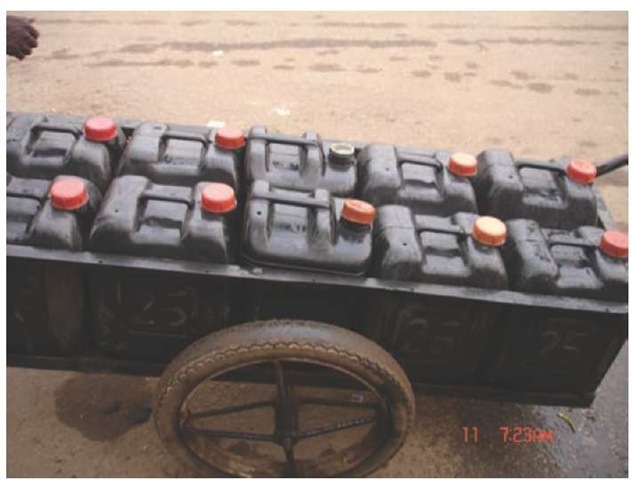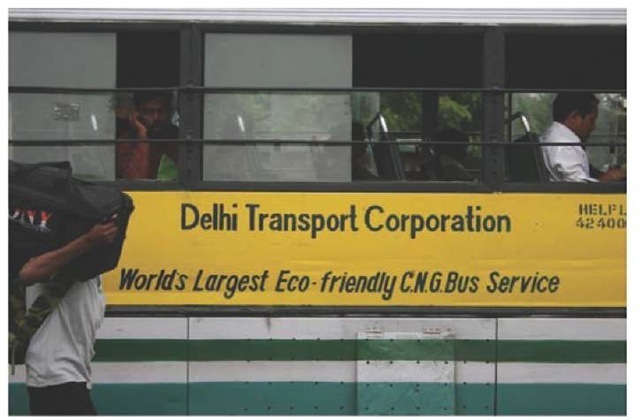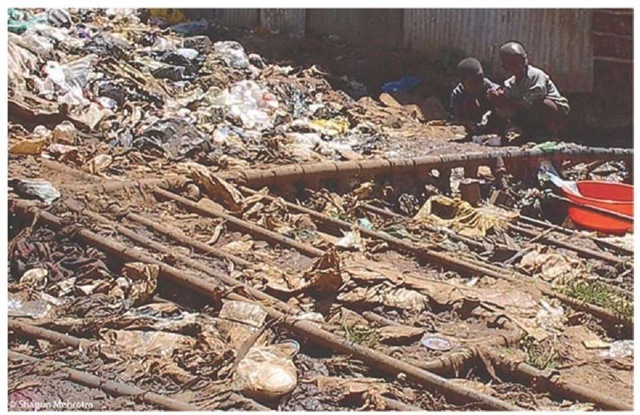Climate change, water, and wastewater in cities
Urban water systems include water supply sources, conveyance, distribution, reuse, treatment, and disposal elements, all of which may be vulnerable to a changing climate (Figure 5).
Within cities, impervious surfaces and increased precipitation intensity can overwhelm current drainage systems. In Mexico City, the city’s 27 treatment facilities currently handle only a fraction of the total sewage generated citywide, and as the local population increases, the ability of the system to accommodate runoff has become compromised, raising the risk of flooding around the city.
In many cities, the quantity and quality of the water supply will be significantly affected by the projected increases in both flooding and droughts, amplifying the need for cities to focus on upgrading their supply networks to maximize the availability of existing supplies. For example, in developed country cities, leakage from the supply distribution system can be severe, resulting in system losses of between approximately 5% and more than 30%. In developing country cities, the supply problem is often different, as significant numbers of people rely on informal water supply systems. In Lagos, for instance, 60% of the population uses informal distribution systems (Figure 6), which are far more vulnerable to drought-induced stoppages.
A range of adaptation measures will be required to ensure water supplies of adequate quantity and quality, especially in coastal regions where water sources and infrastructure are subject to the impacts of rising sea level, higher storm surge, salt-water intrusion, and land subsidence. Cities are pursuing a range of strategies to address these water and wastewater challenges, including:
• Reduce non-revenue water, which constitutes a significant fraction of supply in many urban areas, through leak detection and repair and reduction in unauthorized withdrawals;
• Review and modify surface water and groundwater sources, storage facilities, and intakes where appropriate to make supplies less vulnerable to climate-induced risks such as floods and droughts;
• Implement innovative local supply augmentations where feasible through techniques such as rainwater harvesting and water reuse, as well as through improved water accounting from better observation networks and holistic modeling;
• Practice demand management through appropriate pricing (including social, environmental and economic objectives), public education on water use and conservation, improved toilet and shower codes, updated drought management plans, and targeted land-use strategies; and
• Encourage the use of water-efficient processes in domestic, industrial, and agricultural uses.
Figure 6: Informal urban water supply: a water vendor’s cart in Lagos.
Climate change and urban transportation systems
Globally, according to the IPCC 2007 report, the transport sector accounted for 23% of the world’s greenhouse gas emissions related to energy in 2004, although in some cities, the percentage is much higher, a reflection of local land use and mobility patterns. Cities are adopting a range of strategies to reduce transport-related emissions, including promoting transit-oriented development, reclaiming roadways to provide more space for bicycles and pedestrian walkways, and increasing the amount of mass transit systems available around the city.
Regulatory and pricing instruments are also increasingly being deployed to reduce the volume, timing, or location of private vehicle use, often with significant impact. In London, a congestion pricing program resulted in a 12% decrease in traffic levels in the congestion pricing zone, while in Stockholm, there was a 22% reduction in vehicle passages in the congestion zone. Beijing, Bogota, and Mexico City have all pursued limits on the number of days vehicles can be driven, but this approach may penalize households in locations where public transportation is inadequate. Other cities have focused on promoting more efficient fuels and technology as a means of reducing transport-related carbon emissions. In Delhi, for instance, all public transport buses were converted to compressed natural gas (CNG)-operated systems, in response to public action and right-to-clean-air campaigns that brought the issue to the attention of the Supreme Court of India. The Court subsequently issued a series of judgments regulating public transport and air quality. A key lesson from this experience is that leadership for change in cities can arise from diverse stakeholders – be it citizen groups, the private sector, or the judiciary – as well as from city government itself (Figure. 7).
Some of these mitigation strategies will bring climate change adaptation co-benefits, such as new energy-efficient fuel technologies that provide better temperature control for passengers, but others are being undertaken specifically to maintain the integrity of essential transportation infrastructure assets under changing climate conditions, such as improved engineering and management. Maputo is one of four cities benefiting from a UN HABITAT-supported initiative focused on climate planning, with a specific goal of identifying the hard approaches (sea walls, engineered levees, pump stations) and soft, ecosystem-based approaches (wetlands, parks, and planted levees) designed to protect local transportation system assets from coastal flooding. Mitigation and adaptation strategies for city transportation systems include:
• Integrate land use and transportation planning to increase the density of the urbanized portion of developed land, plan for mixed-use development, and enhance the proximity of travelers to transit and/or to their destinations to reduce vehicle miles of travel;
Figure 7: Compressed natural gas public bus, Delhi.
• Construct transport systems with materials that are more resilient to higher temperatures and the potentially corrosive effects of increased exposure to sea water due to sea level rise and coastal flooding;
• Consider the appropriateness of rezoning as an adaptation solution, retreating from the shoreline, and building new transportation facilities farther inland on higher ground;
• Protect transport systems from increased precipitation and flash flooding through the use of larger culverts and catch basins, and replacement of impermeable road surfaces with permeable material and impermeable roof surfaces with green roofs; and
• Introduce operational measures, including traffic closures during extreme weather events; moving rolling stock to flood-protected and/or wind-protected locations; closing traffic on tall bridges during high winds; and using media to indicate hazardous road conditions and safer alternate transportation routes and modes.
Climate change and human health in cities
Cities are subject to unique health risks since larger populations and higher population density amplify the potential for negative outcomes. Climate change is likely to exacerbate existing health risks in cities and to create new ones. Specific impacts include:
• Direct physical injuries and deaths from extreme weather events such as tropical cyclones, storm surges, intense rainfall that leads to flooding, or ice storms that damage trees and overhead structures and produce dangerous transport conditions;
• Illnesses resulting from the aftermath of extreme weather events that destroy housing, disrupt access to clean water and food, and increase exposure to biological and chemical contaminants;
• Water-borne diseases following extended or intense periods of rainfall, ground saturation and floods, and saline intrusion due to sea level rise; all of which compound existing deficiencies in local water services (Figure 8);
• Food-borne diseases resulting from bacterial growth in foods exposed to higher temperatures;
• Illnesses and deaths from an expanded range of vector-borne infectious diseases;
• Respiratory illnesses due to worsening air quality related to changes in temperature;
• Morbidity and mortality, especially among the elderly, small children, and people whose health is already compromised, as a result of stress from hotter and longer heat waves.
City health agencies can contribute to improvement of knowledge of the health effects of climate change on urban populations and work together with other responsible agencies to reduce the vulnerability of city dwellers to climate variability. Adaptation strategies, many linked to other sectors, land use planning, and governance, include:
Figure 8: Potential health hazards in Kibera related to sanitation and water systems.
• Expand health surveillance and early warning systems utilizing both technology and social networks, especially for the elderly, very young, and the poor;
• Reduce the size of the urban heat island effect through passive approaches such as tree planting, green and reflective roofs, and permeable pavements, thereby minimizing heat stress on all citizens.
• Emphasize water and energy system climate resilience strategies, because of the key role they play in protecting the public during and after extreme weather events; and
• Regulate settlement in flood plains to minimize exposure to coastal storms and inland flooding.



